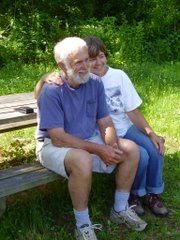
One of the joys of working with Habitat for Humanity in New Orleans is learning about all the organizations that partner with Habitat. The musicians who purchased the land for "Musicians' Village" have gotten a lot of national press, and they really are making a huge impact through their financial contributions and encouraging volunteers to come from around the country.
We are working in New Orleans East, a few miles away from Musicians' Village, where the New Orleans professional basketball team, the Hornets, have been a major contributor. They have committed to build 20 homes this year, come out to raise walls, and advertise Habitat for Humanity at their games.
Last night we cheered the Hornets on to a victory over the Seattle Sonics, courtesy of the team. They donated a large block of tickets to Habitat, and as long-term volunteers, we were part of the group.






















